|
Artemide architectural. Megalit Litech
32 cm, brossura illustrata; p. 400. Catalogo Artemide con numerose tavole a colori. Testi ital/english/deutsch/français

|
|
|
Biograffiti. Für Herbert H. Schultes, den Augenmenschen, den Gestalter, den Romantiker, den Visionär ... zum 60. Geburtstag am 31. Oktober 1998. Idee von Johannes Hirschel, Julius Lengert und Lore Elbracht. Organisiert, realisiert und produziert von Lore Elbracht.
Druck: Döring, München, 1998. Seiten nicht paginiert, überwiegend illustriert; 12° , ca. 15 x 11 cm, kartoniert
Bookseller reference : 29929

|
|
|
Fabrique de lustre en bois rustiques et de styles. Photos Sanson
Paris, s. n., impr. Imprimerie d’Art G. Bouan, Paris 1935 In-4. Couverture grise imprimée, 16 pp., figures dans le texte.
Bookseller reference : 88361
|
|
|
IL POPOLO DI ROMA ANNO X - N. 111 ROMA, VENERDI 11 MAGGIO 1934
In folio. Dim. 58,5x43 cm. Pp. 4.Numero del 11 Maggio 1934 di questo quotidiano politico "Il popolo di Roma" fondato da Mussolini nel 1914 per dare voce all'area interventista del Partito socialista italiano. Dal 1922 divenne l'organo del Partito nazionale fascista. Tra gli argomenti trattati: Presieduto dal Duce il Comitato Corporativo Centrale approva l'istituzione di ventidue Corporazioni, La storica riunione a Palazzo Venezia, il problema del disarmo e le relazioni franco italiane, Le tradizionali feste e la luminaria di San Ranieri a Pisa, Un aereoplano dell'Air France precipita nella Manica, ecc.. In buone condizioni. Raro. Brossura editoriale in buone condizioni generali con lievi usure ai margini e dorso. Piegature e resti di etichetta. All'interno le pagine si presentano in buone condizioni con rare fioriture. Piegature. Number of the 11th of May 1934 of this daily political magazine "Il popolo di Roma" established by Mussolini in 1914 to give voice to the Partito socialista italiano. From 1922 it became the organ of the Partito nazionale fascista. Between the issues treated: The Comitato Corporativo Centrale approves the institution of 22 Corporations, The historical reunion in Palazzo Venezia, German Italian relations, Traditional feasts and luminaria of San Ranieri in Pisa, An airplane of Air France falls in Manica ecc... In good conditions. Scarce copy Editorial cover in good general conditions slightly worn in the edges and spine with signs of labels. Foldings. Inside pages are in good conditions with foxings. Foldings.

|
|
|
Le style Louis XV 50 illustrations
vol broché, 22x15cm, bel exemplaire, 63pp. Paris, Flammarion 1935 ref/177
Bookseller reference : CZC-12502

|
|
|
Le style Louis XV 50 illustrations
vol broché, 22x15cm, bel exemplaire, 63pp. Paris, Flammarion 1935 ref/177
Bookseller reference : CZC-12502

|
|
|
Light cone et Collectif jeune cinéma
Paris 1991 In-4 à l'italienne Broché, couverture illustrée
Bookseller reference : 011978
|
|
|
Mobilier art déco. Madeleine Vionnet. Souvenirs de Jacques Doucet.
Paris Hotel Drouot - Etude Audap, Godeau et Solanet. 1985 Broché, couverture illustrée
Bookseller reference : 013675
|
|
|
PARIS MATCH-N°1794-14 OCTOBRE 1983-MIREILLE DARC
180 PAGES-LA PAIX DU MONDE SE JOUE AU LIBAN; ENTRETIEN DE RICHARD NIXON, 8P-JEAN LE POULAIN SUR LE SUJET DE LA REINCARNATION, 6P-MIREILLE DARC EN REEDUCATION, 6P-ROBERT HOSSEIN, 2P-SEVERIANO BALLESTEROS, 2P-SOPHIE MARCEAU, 4P-EDOUARD LECLERC, PHOTO DE JACQUES LANGE, 2P-SARCELLES LA DEROUTE COMMUNISTE, 6P-MORT DE LEOPOLD DE BELGIQUE, 8P-FRANCOIS MITTERRAND A L'O.N.U. LA MEFIANCE AMERICAINE, 2P-GUERRE IRAN/IRAK, 6P-DOMINIQUE FERRY, LE PDG AU COUVENT, 4P-LA TUERIE DU SOFITEL D'AVIGNON; RECONSTITUTION DE LA PREPARATION DU CASSE MANQUE ET DE LA TRAQUE DE JEAN ROUSSEL ET SES COMPLICES, 5P-DITES NOUS MOBUTU SESE SEKO, 1P-LES MYSTERES DE TINO ROSSI L'ENCHANTEUR, 6P-HARVARD CHAMPIONNE DES NOBEL, 11P-LA GRANDE PARADE DES ROLLS, VENTE AUX ENCHERES CHEZ CHRISTIE'S A LONDRES, 6P-CRITIQUES PAR GILLES PUDLOWSKI DES LIVRES "VASILE EVANESCU, L'HOMME A LA TETE D'OISEAU" D'ALAIN ABSIRE ET "MARIA VANDAMME" DE JACQUES DUQUESNE-"MOISE" DE ROSSINI RESSUSCITE PAR GEORGE PRETRE, 1P-RACHILDE, 4P-CARTE BLANCHE A SUZANNE LABIN, 1P
Bookseller reference : ABE-1695126942591

|
|
|
"AMPÈRE, ANDRÉ-MARIE. - DEFENDING THE WAVE THEORY OF LIGHT.
Mémoire sur la Détermination de la surface courbe des ondes lumineuses dans un milieu dont l'élasticité est différrente suivant les trois directions principales, c'est-à-dire celles où la force produite par l'élasticité a lieu dans la direction mém...
(Paris, Crochard, 1828). No wrappers. In: ""Annales de Chimie et de Physique, Par MM. Gay-Lussac et Arago."", tome 39 (Sec. Cahier), With halftitle to vol. 39. pp. 113-224. (Entire issue offered). Ampere's paper: pp. 113-145 a. 1 folded engrave plate. The plate with a few, mostly marginal brownspots.
Bookseller reference : 45872
|
|
|
"ARAGO, DOMINIQUE- FRANCOIS et AUGUSTIN FRESNEL. - ESTABLISHING THAT LIGHT VIBRATES TRANSVERSELY.
Mémoire Sur l'Action que les rayons de lumière polarisés exercent les uns sur les autres.
Paris, Crochard, 1819. 8vo. No wrappers. In ""Annales de Chimie et de Physique"", Tome X, 2. Series, Cahier 3. Titlepage to vol. X. Pp. 241-336 (entire issue offered, Cahier 3). Arago and Fresnel's paper: pp. 288-306.
Bookseller reference : 47357
|
|
|
"CLAUDE, GEORGES. - THE INVENTION OF THE NEON LIGHT.
Sur les tubes luminescents au néon.
(Paris, Gauthier-Villars), 1910. 4to. No wrappers. In: ""Comptes Rendus Hebdomadaires des Séances de L'Academie des Sciences"", Tome 151, No 24. Pp. (1099-) 1166. (Entire issue offered). The paper: pp. 1122-24.
Bookseller reference : 59129
|
|
|
"come let us walk in the light of the lord" Isaiah 2
5 Paperback Jan 01 1976
Light cover wear interior pages neat clean like new.Very Good unknown
Bookseller reference : 0717GRR3OA8
|
|
|
"DRUMMOND, THOMAS. - THE INVENTION OF LIMELIGHT, THE ""DRUMMOND LIGHT""
On the means of facilitating the observation of distant stations in geodætical operations. Read May 4, 1826.
(London, W.Nicol, 1826). 4to. No wrappers as extracted from ""Philosophical Transactions"" 1826 - Part III. Pp. 324-337 and 1 engraved plate. A faint dampstain to top of plate.
Bookseller reference : 46535
|
|
|
"DÖBEREINER (DOEBEREINER), J.W. - DOEBEREINER'S LAMP.
Neu entdeckte merkwürdige Eigenschaften des Suboxyds des Platins, des oxydirten Schwefel-Platins und des metallischen Platin-Staubes.
Leipzig, Johann Ambrosius Barth, 1823. Without wrappers as issued in ""Annalen der Physik und Chemie. Hrsg.von Poggendorff"", Bd. 74, Drittes Stück. Pp. 225-336 a. 1 engraved plate (the entire issue offered (Heft 3). Döbereiner's paper: pp. 269-273. Clean and fine.
Bookseller reference : 43352
|
|
|
"EULER, LEONHARD. - LIGHT REFRACTION AND THE WAVE THEORY OF LIGHT.
Expériences pour determiner la Refraction de toutes Sortes de Liqueurs transparantes.
(Berlin, Haude et Spener, 1758). 4to. No wrappers as issued in ""Memoires de l'Academie Royale des Sciences et Belles Lettres"". tome XI, 1756 pp. 235-266 and 1 folded engraved plate. Clean and fine.
Bookseller reference : 48838
|
|
|
"EULER, LEONHARD. - TAILS OF COMETS - NORTHERN LIGHTS - ZODIACAL LIGHT.
Recherches Physiques sur la Cause de la Queüe des Cometes, de la Lumiere Boreale, et de la Lumiere Zodiacale. (Physical Investigations on the tail of comets, the northern lights, and the zodiacal light)
(Berlin, Haude et Spener, 1748). 4to. No wrappers as issued in ""Memoires de L'Academie Royale des Sciences et des Belles Lettres."", Tome II, pp. 117-140 and 2 folded engraved plates.
Bookseller reference : 46604
|
|
|
"FARADAY, MICHAEL. - ""THE ELECTRO-MAGNETIC THEORY OF LIGHT""
Sur de nouvelles relations entre l'électricité, la lumière et le magnétisme. (Extrait d'une Lettre de M. Faraday à M. Dumas).
(Paris, Bachelier), 1846. 4to. No wrappers. In: ""Comptes Rendus Hebdomadaires des Séances de L'Academie des Sciences"", Tome 22, No 3. Pp. (92-) 134. (Entire issue offered). Faraday's letter: pp. 113-115.
Bookseller reference : 49069
|
|
|
"FIZEAU, ARMAND HIPPOLYTE & JEAN BERNARD LÉON FOUCAULT. - CONFIRMING THE WAVE THEORY OF LIGHT.
Sur les phénomène des interférences entre deux rayons de lumiere dans le cas de grandes differences de marche. (+) Sur les phénomène des interférences entre deux rayons de lumiere dans le cas de grandes differences de marche, et sur la polarisation ch...
Paris, Victor Masson, Imprimerie de Bachelier, 1849-50. No wrappers. In ""Annales de Chimie et de Physique"", 3me Series - Tome XXVI a. XXX., Juin 1849 a. Octobre 1850. (The entire issues offered). Titlepages to vol. 26 a. 30. Pp. 129-256 a. pp. 129-256. Fizeau & Foucault's paper: pp. 138-148 a. pp. 146-159, 2 folded engraved plates. Some scattred brownspots.
Bookseller reference : 43827
|
|
|
"FIZEAU, H. (ARMAND HIPPOLYTE). - THE FIRST TERRESTRIAL MEASUREMENT OF THE VELOCITY OF LIGHT.
Sur une expérience relative à la vitesse de propagation de la lumière. (Séance du Lundi 23 Juillet 1849).
Paris, Bachelier, 1849. 4to. No wrappers. In ""Comptes rendus hebdomadaires des séances de l’Académie des sciences"", Vol. 29, No 4. With htitle a. titlepage to vol. 29. Pp. 65-96 (entire issue offered). Fizeau's paper: pp. 90-92. Stamps on title-page. Clean and fine.
Bookseller reference : 49457
|
|
|
"FOUCAULT, (JEAN BERNARD LEON) - EXPERIMENTAL EVIDENCE FOR THE WAVE-THEORY OF LIGHT.
Sur les Vitesses relatives de la Lumière dans L'Air et dans L'Eau.
Paris, Victor Masson, 1854. No wrappers. Extracted from ""Annales de Chimie et de Physique"", 3me Series - Tome 41. With titlepage to Tome 41. Pp. 120-164 and 1 large folded engraved plate showing the experimental apparatus. Some foxing throughout.
Bookseller reference : 44783
|
|
|
"FRESNEL, AUGUSTIN ( ARAGO, AMPÉRE, BIOT, FOURIER). - THE FINAL DOWNFALL OF THE CORPUSCULAR THEORY OF LIGHT.
Mémoire sur la Diffraction de la lumière, où l'on examine particululièrement le phénomène des franges colorées que présentent les ombres des corps éclairés par un point lumineux. - Extrait d'une Lettre de M. Fresnel à M. Arago, sur l'influence de ...
Paris, Crochard, 1816-25. Bound in 2 fine recent hmorocco. In: ""Annales de Chimie et de Physique, Redigées par MM. Gay-Lussac et Arago"", Tome I, IV, IX, X, XI, XV, XVII, XX, XXI, XXIII, XXVIII and XXIX. Some memoirs with scattered brownspots. All but volume 15 with the orig. titlepages to the volumes. Vol. XV having instead of the titlepage, a sample of the orig. printed wrappers, December issue 1820. Bound at end of volume 2. The memoir, no. 25a below is inserted at the end of volume 2. Some of the memoirs having textillustrations. Some versos of titlepages with stamps.
Bookseller reference : 44516
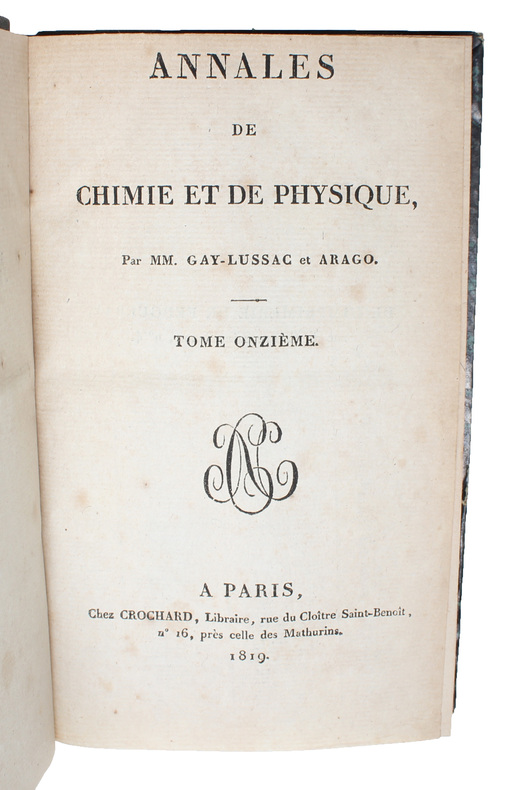
|
|
|
"FRESNEL, AUGUSTIN. - EXPOUNDING THE WAVE THEORY OF LIGHT.
Mémoire Sur les couleurs développées dans des Fluides homogènes par la lumière polarisée. (Presenté à l'Academie, le 30 mars 1818) (+) Mémoire sur la Réflexion de la Lumiere. (Presenté à l'Academie, le 15 novembre 1819). (2 Memoirs).
Paris, Victor Masson, 1846. No wrappers as extracted from ""Annales de Chimie et de Physique"", Tome 17, Troisieme Série. Titlepage to tome 17. Pp. 172-199 a. 1 engraved plate + pp. 316-338, textillustr. Brownspots to titlepage and some browspots to the second memoir.
Bookseller reference : 44101
|
|
|
"FRESNEL, AUGUSTIN. - ESTABLISHING THAT LIGHT IS A TRANSVERSE WAVE
Note sur le Calcul des teintes que la polarisation développe dans les lames cristallisées. (+) IIe Note sur la Coloration des lames cristallisées. (+) Addition à la IIe Note insérée dans le Cahier précédent, par M. Fresnel. (+) Note sur les remarque...
Paris, Crochard, 1821. Contemp. hcloth. Gilt lettering to spine. Weak crack in fronthinge (but still firm). In: ""Annales de Chimie et de Physique, Redigées par MM. Gay-Lussac et Arago"". 448 pp., 1 folded plate. Some browning to htitle, title-page and last leaf, otherwise clean. Fresnel's papers: pp. 102-111, 167-196, 312-315 a. 393-403. Biot, Arago, Ampee: pp. 80-102, 225-258 a. 258-273.
Bookseller reference : 49603
|
|
|
"FRESNEL, AUGUSTIN. - EXPOUNDING THE WAVE THEORY OF LIGHT.
Ueber die durch polarisirtes Lichts in homogenen Flüssigkeiten hervorgebrachten Farben. (...der Pariser Academie am 30. März 1818 vorgelegt). (+) Ueber die Reflexion des Lichts. (Der Pariser Academie vorgelegt am 15. Nov. 1819). (2 Mémoirs).
Leipzig, Johann Ambrosius Barth, 1848. Without wrappers. In ""Annalen der Physik und Chemie. Hrsg. von J.C. Poggendorff"", Ergänzungsbd., Bd. II, Stück 2. Titlepage to Erg-Bd. 2. Pp. 193-368. (The entire issue offered). Fresnel's papers: pp. 304-331, textillustr. a. pp. 332-355, textillustr. A stamp on titlepage and verso of. Clean and fine.
Bookseller reference : 44100
|
|
|
"FRESNEL, AUGUSTIN. - ON THE REFRACTION OF LIGHT.
Explication de la Réfraction dans le système des ondes. (+) Sur l'Ascension des nuages dans l'atmosphere.
Paris, Crochard, 1819. Contemp. hcalf. Spine gilt. Stamps to verso of titlepage. In ""Annales de Chimie et de Physique"", Tome XXI, 2. Series. 448 pp. a. 1 engraved plates. (Entire volume offered). Fresnel's papers. pp. 225-241, textillustr. and pp. 260-263. Clean and fine.
Bookseller reference : 48081
|
|
|
"FRESNEL, AUGUSTIN. - ON THE REFRACTION OF LIGHT.
Explication de la Réfraction dans le système des ondes. (+) Sur l'Ascension des nuages dans l'atmosphere.
Paris, Crochard, 1819. Contemp. hcloth. Gilt lettering to spine. In ""Annales de Chimie et de Physique"", Tome XXI, 2. Series. 448 pp. a. 1 engraved plates. (Entire volume offered). Fresnel's papers. pp. 225-241, textillustr. and pp. 260-263. Internally fine.
Bookseller reference : 48229
|
|
|
"FRESNEL, AUGUSTIN. - OVERTHROWING THE CORPUSCULAR THEORY OF LIGHT
Mémoire sur la Diffraction de la lumiere, où l'on examine particulierement le phènomene des franges colorées que présentent les ombres des corps éclairés par un point lumineux. (Ce Mémoire a été déposé a l'Institut le 33 octobre 1815). (+) Mémoire...
Paris, Crochard, 1816, 1819. Bound in 2 contemp. hcloth. Gilt lettering to spines. In: ""Annales de Chimie et de Physique"" Series 2, Tome 1 a. Tome 11. Entire volumes offered.(4),452 pp. a. 3 engraved folded plates. + 448 pp. a. 3 folded engraved plates. Fresnel's papers: pp. 239-281 a. pp. 246-296 a. pp. 337-378. Arago's paper: pp. 5-30. Some scattered brownspots.
Bookseller reference : 44120
|
|
|
"FRESNEL, AUGUSTIN. - OVERTHROWING THE CORPUSCULAR THEORY OF LIGHT.
Mémoire Sur la Diffraction de la lumière, où l'on examine particulièrement le phénomène des franges colorées que présentent les ombres des corps éclairés par un point lumineux. (Memoir on the Diffraction of Light....)
(Paris, Crochard, 1816) No wrappers. In: 'Annales de Chimie et de Physique', Tome I, Sec. Series, Cahier Mars 1816. With htitle to vol. I. Pp. 225-336 and 1 folded engraved plate. (The entire issue offered). Fresnel's paper: pp. 239-281. The plate shows the diffraction patterns.
Bookseller reference : 43910
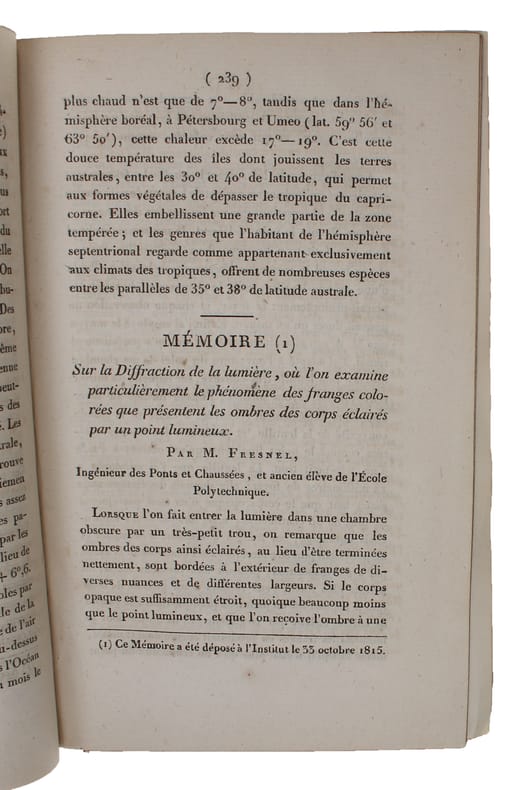
|
|
|
"FRESNEL, AUGUSTIN. - THE ABERRATION OF LIGHT.
Lettre de M. Fresnel à M. Arago, sur l'influence du mouvement terrestre dans quelques phénomènes d'optique.
Paris, Crochard, 1818. No wrappers. In: ""Annales de Chimie et de Physique, Par MM. Gay-Lussac et Arago."", tome 9, Cahier 1. Titlepage to vol. 9. Pp. 5-112 a. 1 folded engraved plate. (The entire issue offered). Fresnel's paper: pp. 57-66. Small stamps on verso of titlepage.
Bookseller reference : 44121
|
|
|
"FRESNEL, AUGUSTIN. - THE ABERRATION OF LIGHT.
Lettre de M. Fresnel à M. Arago, sur l'influence du mouvement terrestre dans quelques phénomènes d'optique. (+) Note additionnelle à Lettre de M. Fresnel à M. Atago, insérée dans le dernier Cahier des Annales.
Paris, Crochard, 1818. No wrappers. In: ""Annales de Chimie et de Physique, Par MM. Gay-Lussac et Arago."", tome 9, Cahier 1 a. 3. Titlepage to vol. 9. Pp. 5-112 a. 1 folded engraved plate + pp. 225-336. (The entire issues offered). Fresnel's paper: pp. 57-66 a. pp. 286-287.
Bookseller reference : 49072
|
|
|
"FRESNEL, AUGUSTIN. - THE UNDULATORY THEORY OF LIGHT ESTABLISHED.
Ueber die Diffraction des Lichts. (Mèmoires de l'acad. roy. des Scences etc. T. V. p. 339). (+) Auszug aus einer Abhandlung über die Reflexion des Lichts. (Ann. de chim. et de phys. T. XV p.379).
(Leipzig, Joh. Ambrosius Barth, 1833). Contemp. hcalf. Spine gilt. Very light wear to spine ends and edges. In: ""Annalen der Physik und Chemie. Hrsg.von Poggendorff"", Jahrgang 1833 (Bd. 30), Ergäntzungsheft. 376 pp. a. 2 folded engraved plates. 2 small stamps to p.1 and a small stamp to verso of plates. (Entire volume offered). Fresnel's papers: pp. 100-255 a. pp. 255-261. Clean and fine.
Bookseller reference : 43919
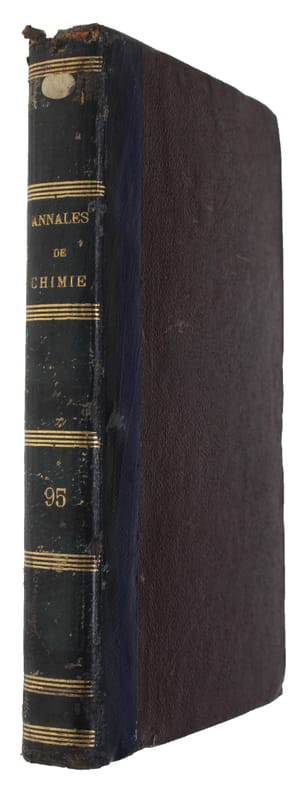
|
|
|
"GLAZEBROOK, R.T. - CONFIRMING FRESNEL'S WAVE THEORY OF LIGHT.
An Experimental Determination of the Values of the Velocities of Normal Propagation of Plane Waves in different directions in a Biaxial Crystal, and a Comparison of the Results with Theory. 2 parts.
(London, Harrison and Sons, 1879). 4to. No wrappers as extracted from ""Philosophical Transactions"" 1879 - Vol. 170 - Part I. Pp. 287-377a.26 textillustrations.
Bookseller reference : 45759
|
|
|
"KUNDT, AUGUST. - ANOMALOUS DISPERSION OF LIGHT EXPLAINED.
Ueber die anomale Dispersion der Körper mit Oberflächenfarben.
(Leipzig, Johann Ambrosius Barth, 1871). Without wrappers as issued in ""Annalen der Physik und Chemie. Hrsg. von J.C. Poggendorff"", 142. Bd., 1. issue (""Heft"" No 1, 1871). Titlepage to vol. 142. Titlepage with small stamps on verso Pp. 1-176 a. 4 folded engraved plates (entire issue offered). Kundt's paper: pp. 163-171.
Bookseller reference : 43538
|
|
|
"LEBEDEW, PETER. - CONFIRMING MAXWELL'S HYPOTHESIS OF THE PRESSURE OF LIGHT.
Untersuchungen über die Druckkräfte des Lichtes.
Leipzig, Ambrosius Barth, 1901. Without wrappers. In: ""Annalen der Physik"", Vierte Folge, Bd. 6, No. 11. (Entire issue offered). Pp. 433-458. Lebedew's paper: pp. 433-458., textillustrations. Clean and fine.
Bookseller reference : 43631
|
|
|
"LORENZ, L. (LUDVIG VALENTIN). - ESTABLISHING THE ELECTRO-MAGNETIC THEORY OF LIGHT.
Om Identiteten af Lyssvingninger og elektriske Strømme. Meddelt den 25. Jan. 1866. (On the Identity of light- vibrations and electrical Currents - Ueber die Identität der Schwingungen des Lichts mit den elektrischen Strömen - Sur l'identité des vibrat...
Kjöbenhavn, Bianco Luno, 1867. Contemp. hcalf. Gilt spine with gilt lettering. In: ""Oversigt over det Kongelige danske Videnskabernes Selskabs Forhandlinger... i Aaret 1867"". X,273,49,(3) pp., textillustrations and plates. (Entire volume offered). Lorenz's paper: pp. 26-45 and pp. 9-16 (Resumé en Francais). Clean and fine.
Bookseller reference : 53255
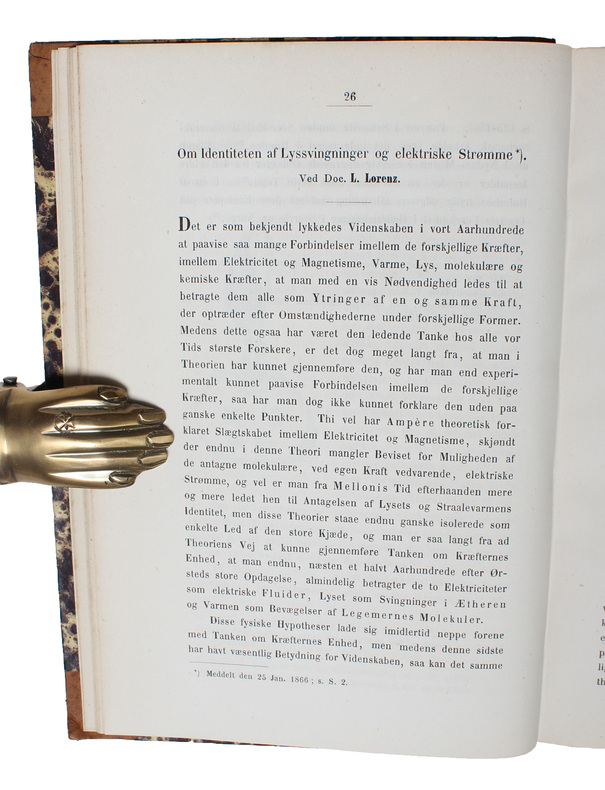
|
|
|
"LORENZ, L. (LUDWIG VALENTIN) - LIGHT IS IDENTICAL WITH ELECTROMECANICAL WAVES.
Om Identiteten af Lyssvingninger og elektriske Stømme. (On the Identity of the Vibrations of Light with electrical Currents).
(København, 1867). Contemp. marbled clothbacked boards. Titlelabel with gilt lettering on upper cover. Pp. 26-45. Extracted from ""Oversigt over det Kgl. danskeVidenskabernes Selskabs Forhandlinger 1867, Nr. 1"".
Bookseller reference : 55371
|
|
|
"MAJORANA, Q. - PROVING THAT THE SPEED OF LIGHT IS INDEPENDENT OF ITS SOURCE.
Démonstration experimentale de la constance de vitesse de la lumiére réfléchie par un miroir en mouvement.
(Paris, Gauthier-Villars), 1917. 4to. No wrappers. In: ""Comptes Rendus hebdomadaires des Séances de L'Academie des Sciences"", tome 165, No 14. Pp. (417-) 448. (Entire issue offered). Majorana's paper: pp. 424-428. A stamp in upper right corner of the first page.
Bookseller reference : 48169
|
|
|
"MARALDI, (GIOVANNI DOMENICO). - THE VELOCITY OF LIGHT.
Considerations sur la seconde inégalité du mouvement des Satellites de Jupiter, & sur l'hypothese du mouvement successif de la lumiere.
(Paris, Jean Boudot, 1708). 4to. Without wrappers. Extracted from ""Mémoires de l'Academie des Sciences"". Année 1707. Pp. 25-32. A small tear to inner margins.
Bookseller reference : 46058
|
|
|
"MAXWELL, JAMES CLARK. - THE INTRODUCTION OF THE ""ELECTRICAL FORMULATION"" OF THE ELECTROMAGNETIC THEORY OF LIGHT.
On a Method of making a Direct Comparison of Electrostatic with Electromagnetic Force"" with a Note on the Electromagnetic Theory of Light. (Read June 18, 1868).
(London, Taylor & Francis, 1869) Large 4to. Without wrappers. Extracted from ""Philosophical Transactions of the Royal Society of London."", Vol. 158. Maxwell's paper: pp. 643-657. Clean and fine, wide margins.
Bookseller reference : 42029
|
|
|
"RITTER, (JOHANN W.). - THE DISCOVERY OF ""CHEMICAL RAYS"" - ULTRAVIOLET LIGHT AND RADIATION.
Announcing his discovery of ultraviolet light ""Von den Herren Ritter und Bückmann. - - Am 22sten Febr. habe ich auch auf der Seite des Violetts im Farbespectrum, ausserhalb desselben, Sonnenstrahlen angetroffen....
Halle, Rengerschen Buchhandlung, 1801. Without wrappers as published in ""Annalen der Physik. Herausgegeben von Ludwig Wilhelm Gilbert"", Bd. 7, Viertes Stück. The entire issue offered (=Heft 4). Pp. 387-528. Ritter's announcement p. 525. With titlepage to volume 7. Clean and fine. Titlepage a bit shavedin inner margin.
Bookseller reference : 43492
|
|
|
"RITTER, (JOHANN W.). - THE DISCOVERY OF ULTRAVIOLET LIGHT.
Versuche über das Sonnenlicht.
Halle, Rengerschen Buchhandlung, 1803. Without wrappers as extracted from ""Annalen der Physik. Herausgegeben von Ludwig Wilhelm Gilbert"", Jahrgang 1802, Bd. 12, Zwölftes Stück. Pp. 409-416. Titlepage to vol. 12.
Bookseller reference : 43638
|
|
|
"WEBER, W. (WILHELM) AND R. KOHLRAUSCH. - THE VELOCITY OF LIGHT.
Ueber die Elektricitätsmenge, welche bei galvanischen Strömen durch den Querschnitt der Kette fliest.
Leipzig, Johann Ambrosius Barth, 1867. Contemp. hcalf, raised bands, gilt spine with gilt lettering. A few scratches to binding. In ""Annalen der Physik und Chemie. Hrsg.von Poggendorff"", Bd. 99. (Entire volume offered). (2),X,652 pp. and 4 folded engraved plates. Weber & Kohlrausch's paper:pp. 10-25.
Bookseller reference : 43497
|
|
|
"YOUNG, THOMAS. - THE DISCOVERIES OF THE INTERFERENCE OF LIGHT - GERMAN EDITIONS.
Ueber die Theorie des Lichts. Frei übersetzt vom Professor Lüdicke. (+) Nachricht von einigen Fällen einer bisher noch nicht beschriebenen Entstehung der Farben. (+) Beschreibung einer Vorrichtung, um mittelst des Sonnen-Mikroskops die Farben dünner F...
Leipzig, Johann Ambrosius Barth, 1811. Without wrappers. In: ""Annalen der Physik. Hrsg. Ludwig Wilhelm Gilbert"", Bd. 39 (der Reihe), Eilftes u. Zwölftes Stück. Titlepage to vol. 39. Pp. 129-244 a. 2 engraved plates. (The entire issue offered). Young's papers: pp. 156-205 a. pp. 206-220. And pp. 245-360 a. 2 engraved plates. (The entire issue offered). Young's papers: pp. 255-261 a. pp. 262-290.
Bookseller reference : 44092
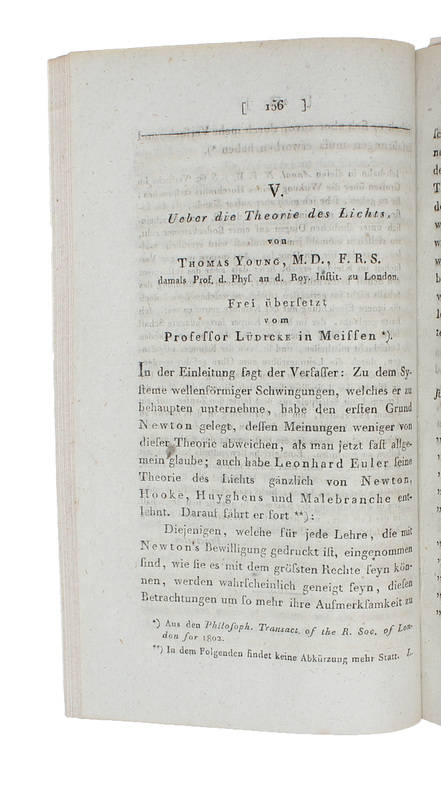
|
|
|
' HOLD TO THE LIGHT ' Star Chart
Chart of the Heavens Shewing the Stars Visible on Any Night Throughout the Year
A ' hold to the light ' transformation hand coloured star chart with the stars represented when held to the light. Attractive item. No publisher or date which we would guess as circa 1860 . Very Good. 285 x 225 Mm. Print. unknown
Bookseller reference : 001961

|
|
|
(Ad hoc) Winnipeg Committee of Unemployed Youth and Veterans of the Great Depression
Two Major Depressions in One Life Time
72 pages. Circa 1982-83. Perhaps the first book to be written by workers on the question of Canada's entering the second depression. Their dismay at finding another generation of young families faced with the same prospects of unemployment, has prompted them to compile an outline of world and national development leading to recurring crises in private enterprise systems. The authors have used a historical materialist approach in attempting to make the history and background of depressions understandable to the average working class reader. Gift greetings inside front cover else clean and unmarked. Light wear. Very nice copy. Book
|
|
|
(Hrsg.)
Das Internationale Design Jahrbuch 1989/90.
Mchn., Bangert (1989). 4°, 240 S., mit 448, meist farb. Abb., OPp. m. farb. OU.
Bookseller reference : EEzz6957
|
|
|
(Kemp, Philip Robert).
THE REASON WHY : General Science. A Careful Collection of Many hundreds of reasons for things which, though generally believed, are imperfectly understood. A Book of Condensed Scientific Knowledge for the Million.
pp. xxvi, 346, (13) [Fascinating publishers' catalog from Dick & Fitzgerald, New York].Woodcut text illustrations. Early Pencil ownership of W. M. Kuhns. 12mo. 190 mm. Crisp original full cloth binding. Front board tooled in blind, with a central rising sun in gilt bearing the words "The Reason Why." The spine nicely tooled and lettered in gold gilt with the title and various symbols of learning and wisdom. A handsome example from popular a series of informative 'Reason Why' books that cover a wide rage of topics, usually attributed to Robert Kemp Philp (1819-1882). Hardbound. Very good+. NW53 BINDINGS
|
|
|
- Lelièvre Léo,Nast Paul - Lelièvre Léo,Narva H.
Partition de la chanson : Abat-jour (Les)
Dufrenne 1921 approx.
Bookseller reference : 29445
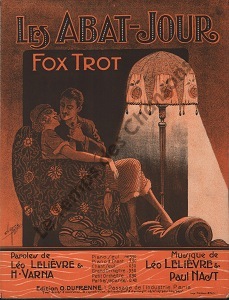
|
|
|
1 Ed. Gregg Allman Alan Light Unknown Binding
My Cross to Bear
Hardcover. Very Good. 1st Edition 1st printing HCDJ clean no marks. hardcover
Bookseller reference : BHW-2BX-ZBW
|
|